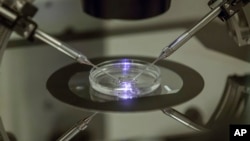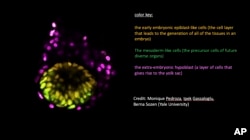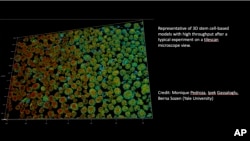Scientists say they have successfully created embryo models designed to support research on early human development.
The models are made from stem cells – simple cells in the body that can develop into one of many specialized cells. Researchers say the embryo models cannot grow into babies. But they are meant to be complete enough to provide information about what might be going on in the embryo during a pregnancy.
The use of embryo models permits scientists to carry out research without the ethical concerns linked to experiments using real embryos.
Several groups are working on the research. Teams from the United States and England shared their work in two studies that recently appeared in the publication Nature. Other scientists in Israel and China published studies on their work earlier this month. Those studies, however, have not yet been examined by a wider community of scientists.
Insoo Hyun is an ethicist and director of life sciences at Boston’s Museum of Science. He is also a member of the Center for Bioethics at Harvard Medical School.
Hyun told The Associated Press that past research has centered on a process that creates “pre-embryos” designed to behave like real embryos. But the latest creations model an embryo after it has reached the uterus. Real human embryos can be extremely hard to see at that point in the process because they attach themselves deep into the uterus.
Each team’s models differ in how complete they are, Hyun said. For these kinds of models, scientists use a kind of stem cell that is able to develop into many different kinds of cells or tissues in the body. They can be formed from embryos or reprogrammed from adult tissues.
The writers of several studies described models that look similar to human embryos nine to 14 days after fertilization.
Berna Sozen studies developmental stem cell biology at Yale University in Connecticut. She told The Associated Press, “If we can experimentally model this period, then we can finally start asking questions about how human development happens in those very early stages that are normally hidden within the body of the mother.”
Sozen added that scientists should be able to use the models to study embryonic failure, developmental disorders and pregnancy loss. Currently, scientists do not understand a lot about how those things happen, she said.
Another study was led by Magdalena Zernicka-Goetz, an expert in stem cell biology at the California Institute of Technology and the University of Cambridge in England. She said the model her group worked with appears similar to embryo development up to 14 days from fertilization.
The researchers say that model contains embryonic tissues and other tissues that can produce structures surrounding the embryo, such as the placenta and yolk material. The placenta is a structure that develops in pregnancy and attaches to the uterine wall.
In the future, Zernicka-Goetz said researchers could use human embryo models to explore the effects of the environment and chemicals on early human development.
Yale University’s Sozen said scientists could also test drugs on embryo models and combine them with germs in experiments that currently cannot be done on pregnant individuals.
I’m Bryan Lynn.
The Associated Press reported this story. Bryan Lynn adapted the report for VOA Learning English.
_____________________________________________________________
Words in This Story
ethical – adj. relating to what is right or wrong
uterus – n. (medical) a term for the organ in a woman that holds the baby during pregnancy; womb
_________________________________________________________________
What do you think of this story? We want to hear from you. We have a new comment system. Here is how it works:
- Write your comment in the box.
- Under the box, you can see four images for social media accounts. They are for Disqus, Facebook, Twitter and Google.
- Click on one image and a box appears. Enter the login for your social media account. Or you may create one on the Disqus system. It is the blue circle with “D” on it. It is free.
Each time you return to comment on the Learning English site, you can use your account and see your comments and replies to them. Our comment policy is here.












Forum